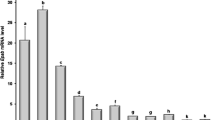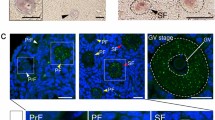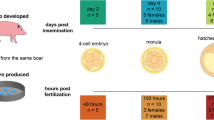Abstract
The metabolism of fatty acids represents an important energy source for early embryonic development. Our knowledge of the molecular basis that regulate this metabolism is very poor. In this study we have analysed the pattern of expression ofCpt-1 andCpt-2 genes, that encode the enzymes CPT-1 and CPT-2, which play a role in long chain fatty acids transport inside the mitochondria. The data obtained from the RT-PCR analysis show a rapid reduction in the number of transcripts from antral oocyte to ovulated MII oocyte and a significant difference between the expression profiles ofCpt-1 andCpt-2 genes during preimplantation development.Cpt-1 is first temporarily expressed at the G2 phase of 2-cell embryo, it disappears at the 4-cell stage and reappears consistently between the 8-cell and morula stage;Cpt-2 is expressed from the MII oocyte, decreases to very low level at the 8-cell stage and is actively transcribed from morula, where it abruptly increases its expression to reach its maximum at the blastocyst stage. Interestingly, the high expression of bothCpt-1 andCpt-2 at the morula stage is correlated with an increasing profile of oxygen uptake and fatty acid oxidation found at this stage of development. Furthermore, this rise of transcription is concomitant with other important epigenetic changes occurring prior to embryo cavitation and involving a reorganisation of chromatin structure and DNA methylation.
Riassunto
Il metabolismo degli acidi grassi rappresenta una importante fonte di energia per l’embrione nelle prime fasi di sviluppo preimpianto. Le conoscenze delle basi molecolari che regolano questo metabolismo sono molto scarse. In questo studio abbiamo analizzato il profilo di espressione dei geniCpt-1 eCpt-2, che traducono per gli enzimi CPT-1 e CPT-2, coinvolti nel trasporto degli acidi grassi a lunga catena all’interno dei mitocondri. I dati, ottenuti dall’analisi molecolare mediante la tecnica della RT-PCR, mostrano una notevole riduzione del numero dei trascritti tra oocita antrale e oocita ovulato in MII, ed una notevole differenza tra i profili di espressione diCpt-1 eCpt-2 durante lo sviluppo preimpianto.Cpt-1 risulta essere temporaneamente espresso allo stadio di embrione a 2 cellule, è silente nell’embrione a 4 cellule e ricompare tra l’embrione a 8 cellule e lo stadio di morula;Cpt-2 è invece già espresso nell’oocita in MII, la sua espressione si riduce gradualmente fino a bassi livelli nell’embrione a 4 cellule, per poi tornare a essere attivamente trascritto nella morula, dove il numero di trascritti incrementa notevolmente fino a raggiungere il picco di espressione nella blastocisti. Significativo è il fatto che l’intensificazione dell’espressione genica diCpt-1 eCpt-2 allo stadio di morula è correlata con l’incremento nel consumo di ossigeno legato alla β-ossidazione degli acidi grassi in questo stesso stadio di sviluppo. Inoltre, questo aumento è concomitante con importanti fenomeni epigenetici che precedono la cavitazione dell’embrione ed implicano la riorganizzazione della struttura della cromatina e la metilazione del DNA.
Similar content being viewed by others
References
Aoki F., Worrand D., Shultz R., 1997.Regulation of Transcriptional Activity during the First and Second Cell Cycles in the Preimplantation Mouse Embryo. Dev. Biol., 181: 296–307.
Bachvarova R., 1985.Gene expression during oogenesis and oocyte development in mammals. Dev. Biol., 1: 453–524.
Bachvarova R., De Leon V., Johnson A., Kaplan G., Paynton B.V., 1985.Changes in total RNA, polyadenylated RNA, and actin mRNA during meiotic maturation of mouse oocytes. Dev. Biol., 108: 325–331.
Bavister B.D., 1995.Culture of preimplantation embryos: facts and artifacts. Hum. Reprod. Update, 1: 91–148.
Bishop D.G., 1971.The distribution and function of lipids in cell. In:A.R. Johnson, J.B. Davenport (eds.),Biochemistry and Methodology of Lipids. Wiley-Interscience, New York.
Bouniol C., Nguyen E., Debey P., 1995.Endogenous Transcription Occurs at the 1-Cell Stage in the Mouse Embryo. Exp. Cell Res., 218: 57–62.
Christians E., Campion E., Thompson E.M., Renard J.P., 1995.Expression of the HSP 70.1 gene, landmark of early zygotic activity in the mouse embryo, is restricted to the first burst of transcription. Development, 121: 545–551.
Clarke H.G., Oblin C., Bustin M., 1992.Developmental regulation of chromatin composition in mouse embryogenesis: somatic histone H1 is first detectable at the 4-cell stage. Development, 115: 791–799.
Davis W. Jr.,De Sousa P.A., Schultz R.M., 1996.Transient expression of translation initiation factor eIF-4C during the 2-cell stage of the preimplantation mouse embryo: identification by mRNA differential display and the role of DNA replication in zygotic gene activation. Dev. Biol., 174: 190–201.
Fulton B.P., Whittingham D.G., 1978.Activation of mammalian oocytes by intracellular injection of calcium. Nature, 273: 149–151.
Hillman N., Flynn T.J., 1980.The metabolism of exogenous fatty acids by preimplantation mouse embryos developing in vitro. J. Embryol. Exp. Morph., 56: 157–168.
Houghton F.D., Thompson J.G., Kennedy C.J., Leese H.J., 1996.Oxygen consumption and energy metabolism of the early mouse embryo. Mol. Reprod. Dev., 44: 476–485.
Kafri T., Gao X., Razin A., 1993.Mechanistic aspects of genome-wide demethylation in the preimplantation mouse embryo. Proc. Natl. Acad. Sci. USA, 90: 10558–10562.
Kane M.T., 1979.Fatty acids as energy sources for culture of one-cell rabbit ova to viable morulae. Biol. Reprod., 20: 323–332.
Kay G.F., Penny J.D., Patel D., Ashworth A., Brockdorf N., Rastan S., 1993.Expression of Xist during mouse development suggests a role in the initiation of X chromosome inactivation. Cell, 72: 171–182.
Kay G.F., Barton S.C., Surani M.A., Rastan S., 1994.Imprinting and X chromosome counting mechanisms determine Xist expression in early mouse development. Cell, 77: 639–650.
Kunieda T., Xian M., Kobayashi E., Imamichi T., Moriwaki K., Toyoda Y., 1992.Sexing of Mouse Preimplantation Embryos by Detection of Y chromosome-Specific Sequences Using Polymerase Chain Reaction. Biol. Reprod., 46: 692–697.
Latham K.E., Rambhatla L., 1995.Expression of X-linked genes in androgenetic, gynogenetic, and normal mouse preimplantation embryos. Dev. Gen., 17: 212–222.
Latham K.E., Rambhatla L., Hayashizaki Y., Chapman V.M., 1995.Stage-specific induction and regulation by genomic imprinting of the mouse U2afbp-rs gene during preimplantation development. Dev. Biol., 168: 670–676.
McGarry J.D., Brown N.F., 1997.The mitochondrial carnitine palmitoyl-transferase system from concept to molecular analysis. Europ. J. Biochem., 244: 1–14.
Nesterova T.B., Barton S.C., Surani M.A., Brockdorff N., 2001.Loss of Xist imprinting in diploid parthenogenetic preimplantation embryos. Dev. Biol., 235: 343–350.
Nothias J.Y., Majumder S., Kaneko K.J., DePamphilis M.L., 1995.Regulation of gene expression at the beginning of mammalian development. J. Biol. Chem., 270: 22077–22080.
Paria B.C., Zhao X., Wang J., Das S.K., Dey S.K., 1999.Fatty-acid amide hydrolase is expressed in the mouse uterus and embryo during the periimplantation period. Biol. Reprod., 60: 1151–1157.
Santos F., Hendrich B., Reik W., Dean W., 2002.Dynamic Reprogramming of DNA Methylation in the Early Mouse Embryo. Dev. Biol., 241: 172–182.
Schultz R.M., 1993.Regulation of Zygotic Gene Activation in the Mouse. BioEssays, 15: 531–538.
Schultz R.M., Davis W. Jr,Stein P., Svoboda P., 1999.Reprogramming of gene expression during preimplantation development. J. Exp. Zool., 285: 276–282.
Sprinks M.T., Sellens M.H., Dealtry G.B., Fernandez N., 1993.Preimplantation mouse embryos express Mhc class I genes before the first cleavage division. Immunogenetics, 38: 35–40.
Stern S., Biggers J.D., Anderson E., 1971.Mitochondria and early development of the mouse. J. Exp. Zool., 176: 179–191.
Thompson E.M., 1996.Chromatin structure and gene expression in the preimplantation mammalian embryo. Reprod. Nutr. Dev., 36: 619–635.
Valdivia R.P., Kunieda T., Azuma S., Toyoda Y., 1993.PCR sexing and developmental rate differences in preimplantation mouse embryos fertilized and cultured in vitro. Mol. Reprod. Dev., 35: 121–126.
Vernet M., Bonnerot C., Briand P., Nicolas J. F., 1992.Changes in permissiveness for the expression of microinjected DNA during the first cleavage of mouse embryos. Mech. Dev., 36: 129–139.
Wales R.G., 1975.Maturation of the mammalian embryo: biochemical aspects. Biol. Reprod., 12: 66–81.
Wang A.M., Doyle M.V., Mark D.F., 1989.Quantitation of mRNA by the polymerase chain reaction. Proc. Natl. Acad. Sci. USA, 86: 9717–9721.
Wassarman P.M., 1988.The mammalian ovum. In:E. Knobil, J. Nail et al. (eds.),The physiology of reproduction. Raven Press, New York: 69–102.
Whittingham D.G., 1971.Culture of mouse ova. J. Reprod. Fertil. Suppl., 14: 7–21.
Zuccotti M., Rossi P.G., Martinez A., Garagna S., Forabosco A., Redi C.A., 1998.Meiotic and developmental competence of mouse antral oocytes. Biol. Reprod., 58: 700–704.
Zuccotti M., Boiani M., Ponce R.H., Guizzardi S., Scandroglio R., Garagna S., Redi C.A., 2002.Mouse Xist expression begins at zygotic genome activation and is timed by a zygotic clock. Mol. Reprod. Dev., 61: 14–20.
Zwingman T., Erickson R.P., Boyer T., Ao A., 1993.Transcription of the sex-determining region genes Sry and Zfy in the mouse preimplantation embryo. Proc. Natl. Acad. Sci. USA, 90: 814–817.
Author information
Authors and Affiliations
Corresponding author
Additional information
Nella seduta del 14 febbraio 2003.
Rights and permissions
About this article
Cite this article
Garagna, S., Gentile, L., Merico, V. et al. Expression of Carnitine Palmitoyl-Transferase 1 and 2 during mouse preimplantation development. Rend. Fis. Acc. Lincei 14, 217–229 (2003). https://doi.org/10.1007/BF02904525
Received:
Revised:
Issue Date:
DOI: https://doi.org/10.1007/BF02904525




